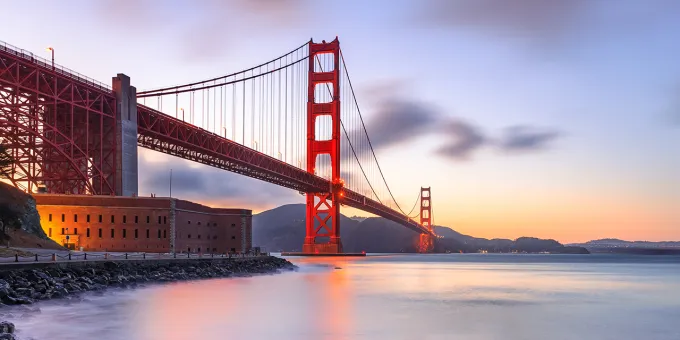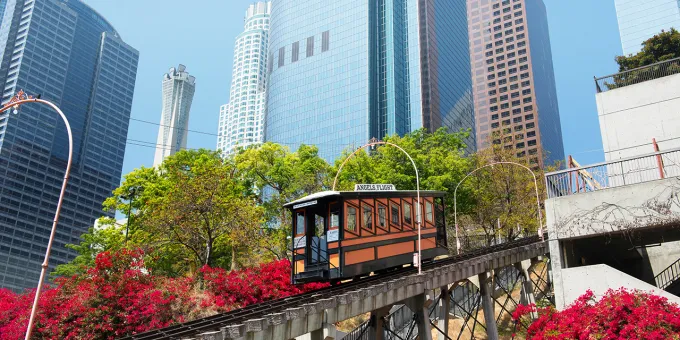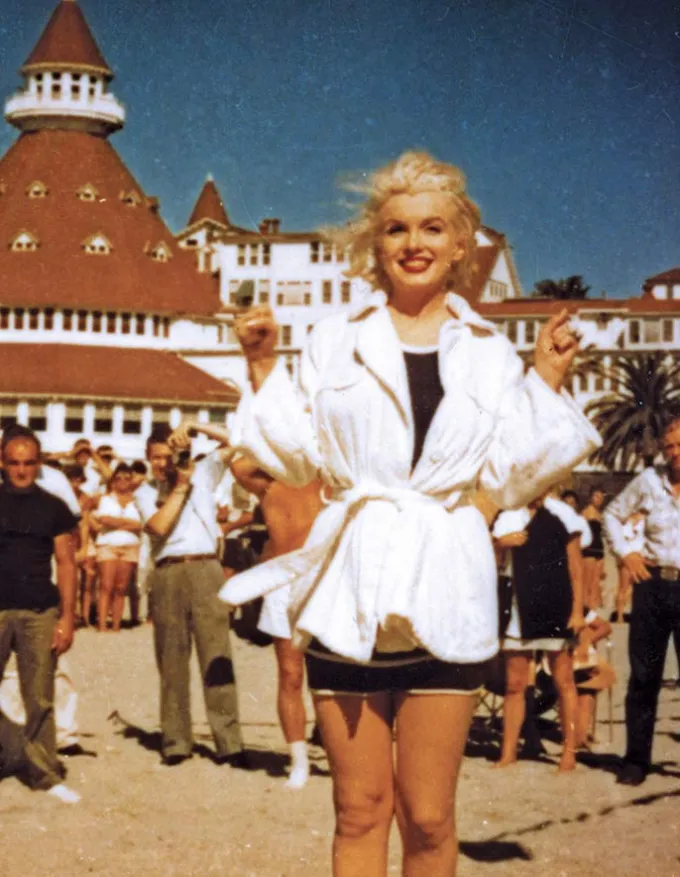In the so-called Golden Age of Hollywood (1910s–1960s), directors turned California into a cinematic wonderland. While today's movie shoots often occur in far-flung locations, American directors in the early days took advantage of their backyard, using California’s variety of terrains to work as stand-ins for global destinations. While many locations have faded away, some are still visible—and accessible. (Angels Flight, for instance, a classic film noir location, also appeared in 2016’s La La Land.) Some areas even play up a location’s famous past, with museums and guided tours.
These classic movie locations only scratch the surface of California’s film appearances. Want even more cinematic magic? Take a Movie Locations Road Trip, go on a Lost Boys tour in Santa Cruz, or learn how movies are made on the Studio Tour at Universal Studios Hollywood.
Here, listed north to south, are some of California’s most recognizable cinematic time capsules, and the stories behind them.
Bodega Bay, The Birds
The coastal Sonoma County villages of Bodega and Bodega Bay exude a sense of moody isolation—and that’s part of the reason Alfred Hitchcock chose them as a backdrop for 1963’s The Birds. In Bodega you can still see the two-story Potter Schoolhouse, where the birds first menaced the town’s children. To go inside a location, book a table at The Tides Wharf Restaurant at The Inn at the Tides to enjoy the Dungeness crab and views over the water—featuring happy (and non-homicidal) shorebirds.
Fort Point, Vertigo
In the 1850s, Fort Point in San Francisco was an integral part of the Pacific defense. While the fort never saw any real military action, it has seen some drama: Kim Novak’s character Madeline attempted suicide here in the 1958 Hitchcock classic Vertigo. Tours at the fort focus more on its history with candlelit tours and cannon-loading demonstrations. To recreate other parts of the film, stroll through the cemetery at Mission Dolores, or stay at the Hotel Vertigo (called the Empire in the movie), where Vertigo plays endlessly on the lobby ceiling.
Spreckels, East of Eden
The tiny town of Spreckels was the location for 1955’s East of Eden, based on John Steinbeck’s tragic tale of sibling rivalry set in Salinas Valley. The Spreckels Sugar Factory, seen in the opening frames, is still operational today and many early-20th-century homes dot the town’s Historic District. In nearby Salinas, you can tour the National Steinbeck Center, which showcases letters and equipment that inspired East of Eden, as well as other Steinbeck books-turned-films, such as The Grapes of Wrath and Of Mice and Men.
Big Bear Lake, Kissin’ Cousins
The San Bernardino Mountains and valleys around Big Bear Lake frequently stood in for various mountain ranges in early films, such as 1936’s The Trail of the Lonesome Pine, 1941’s The Shepherd of the Hills, and Elvis Presley’s 1964 Kissin’ Cousins—all stories of family feuds and moonshine. The sawmill featured in the Presley film is still standing, and you can see it at the Cedar Lake Camp, which was part of the area’s “back lot,” and is now rented out to groups.
Griffith Observatory, La La Land and Rebel Without a Cause
Completed in 1935, the Griffith Observatory is almost as iconic as the Hollywood sign. For today's movie fans, the Observatory may be recognized as where Ryan Gosling and Emma Stone waltzing under a star-filled ceiling in La La Land. The Observatory also served as a location for 1955’s Rebel Without a Cause, when James Dean’s character tries to impress his classmates in the planetarium, only to get caught up in a knife fight. In real life, before his death at age 24, Dean commissioned a bust of himself, which is now on prominent display near the Observatory lawn.
Angels Flight, film noir
In 1901, Angels Flight was built on Los Angeles’ Bunker Hill to ferry locals up the steep incline. During the ’40s and ’50s, the neighborhood and its funicular became a familiar sight in noir films like The Turning Point (1952), M (1951), and Kiss Me Deadly (1955). The recently restored Angel’s Flight is open to ride and provides a great start to a noir walking tour. Get a guided tour from the Los Angeles Conservancy or go it alone, stopping at the Bradbury Building (1950’s D.O.A.) and City Hall (1945’s Mildred Pierce and 1946’s The Blue Dahlia).
Pioneertown, westerns
If Pioneertown reminds you of an Old West cowboy flick, your memory serves you well. Back in 1946, Gene Autry and Roy Rogers (plus other investors), created this frontier town-style movie set near Joshua Tree National Park. Visit today and you can still see the camera-ready façades resembling saloons, jailhouses, and stables. Browse the shops before grabbing a cold one at Pappy & Harriet’s. Once a cantina set for movies, Pappy’s is now a quirky music venue and restaurant/bar, attracting big-name acts as well as local bands.
Venice Beach, Touch of Evil
Venice Beach first opened in 1905, paying homage to its Italian namesake with a Grand Canal, bridges, piers, an amphitheater, and a mini railroad. By the late 1950s, the Los Angeles neighborhood had turned rough from civic neglect, prompting Orson Welles to cast it as a seedy border town in Touch of Evil. Visit the colonnade, where the movie’s famous opening sequence was shot. For a deeper dive, book a Venice in the Movies Walking Tour. Or, get a bird’s-eye view of the area (and perhaps a blood-orange julep) from the High Rooftop Lounge.
Palm Springs, various films
Palm Springs has a reputation as Hollywood’s getaway—but the city and its signature mid-century modern architecture have also served as a location for a number of films. For example, The Damned Don’t Cry was famously shot at Frank Sinatra’s Twin Palms Estate. Visit the home through a city tour during February’s Modernism Week, or rent the place for a few thousand clams a night. You can more easily access another local film site: the Riviera Palm Springs, which served as the hotel in 1963’s Palm Springs Weekend.
Hotel Del Coronado, Some Like It Hot
The Queen Anne–style Hotel del Coronado, located on San Diego’s Coronado Island, served as the luxurious resort in Some Like It Hot. While only exteriors were shot on location, the cast all stayed at the hotel, including Marilyn Monroe, Jack Lemmon, and Tony Curtis (accompanied by wife Janet Leigh, who was pregnant at the time with Jamie Lee). As befits a National Historic Landmark, the Hotel Del has stayed relatively unchanged. For a film-related photo, pose by the Dragon Tree next to the resort entrance, a backdrop for a famous scene featuring Lemmon in drag.


